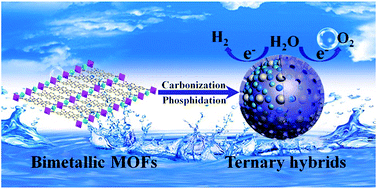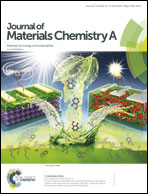Ternary hybrids as efficient bifunctional electrocatalysts derived from bimetallic metal–organic-frameworks for overall water splitting†
Abstract
To explore cost-efficient, highly active and robust bifunctional electrocatalysts for overall water splitting, both the hydrogen evolution reaction (HER) and oxygen evolution reaction (OER), is of much significance for renewable-energy systems but remains challenging as well. Herein, we report two multicomponent heterostructures as efficient bifunctional electrocatalysts, Co2P/Mo2C/Mo3Co3C and Ni/Ni2P/Mo2C nanoparticles encapsulated in porous graphene shells (termed Co2P/Mo2C/Mo3Co3C@C and Ni/Ni2P/Mo2C@C). Two bimetallic MOFs (CoMo-MOF and NiMo-MOF) with ordered heterogeneity were used as precursors to synthesize Co2P/Mo2C/Mo3Co3C@C and Ni/Ni2P/Mo2C@Cvia a facile and versatile two-step method and a direct carbonization process followed by phosphorization. The resultant catalysts manifest superior HER performance with low overpotentials of 154 and 183 mV delivering a current density of 10 mA cm−2 in acidic media. More importantly, both Co2P/Mo2C/Mo3Co3C@C and Ni/Ni2P/Mo2C@C exhibit favorable HER and OER activity under alkaline conditions. Remarkably, Co2P/Mo2C/Mo3Co3C@C affords overpotentials of 182 mV and 362 mV at 10 mA cm−2 for the HER and OER. Moreover, the two catalysts present good stability in both acidic and basic electrolytes. The synergistic effect of the multicomponent electrochemically active species and the uniform distribution, mesoporous structures and carbon coating are beneficial for the charge transfer during the catalytic process, which results in excellent performance, comparable to many reported nonprecious electrocatalysts. Furthermore, Co2P/Mo2C/Mo3Co3C@C catalysts were exploited as both the anode and cathode in a home-made electrolyser with alkaline electrolyte, which can afford 10 mA cm−2 at a cell voltage of 1.74 V.



 Please wait while we load your content...
Please wait while we load your content...